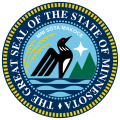| |||||||||||||||||
| |||||||||||||||||
| |||||||||||||||||
The 1877 Minnesota lieutenant gubernatorial election was held on November 6, 1877, in order to elect the lieutenant governor of Minnesota. Republican nominee and incumbent lieutenant governor James Wakefield defeated Democratic nominee and former Mayor of Minneapolis Albert Alonzo Ames and Prohibition nominee Phineas A. Jewell. [1]


